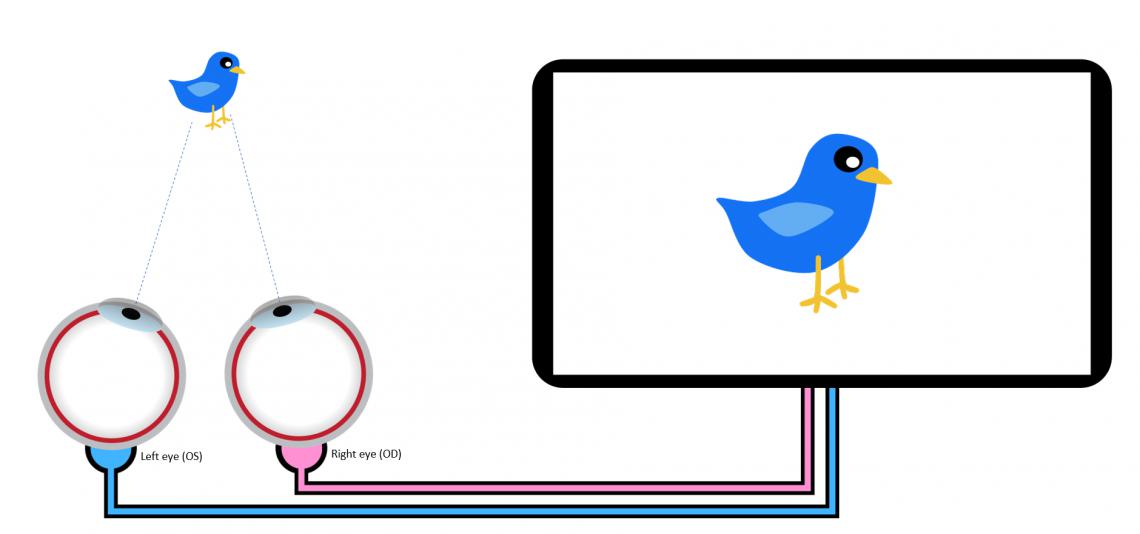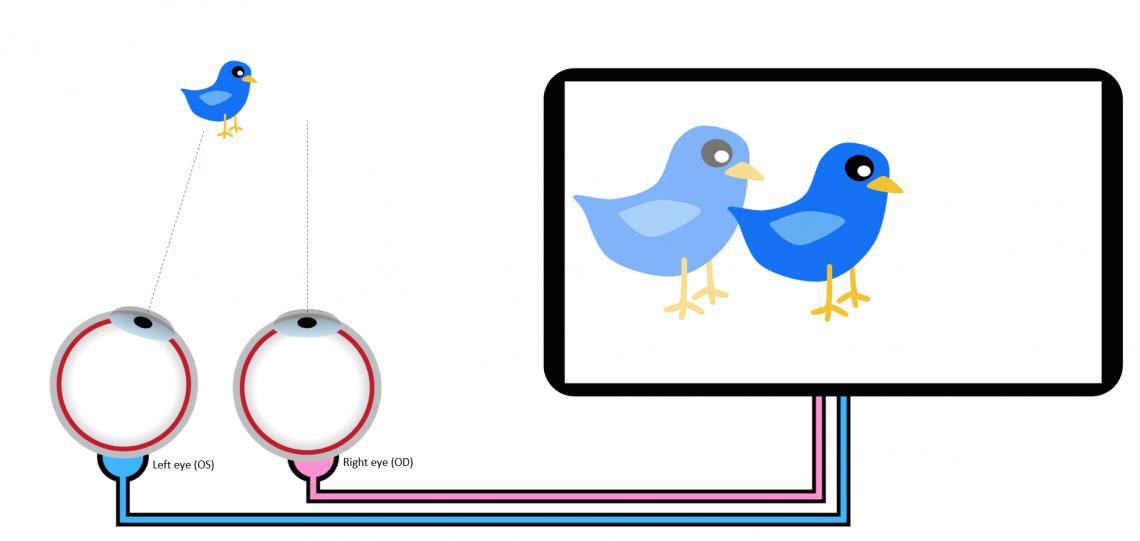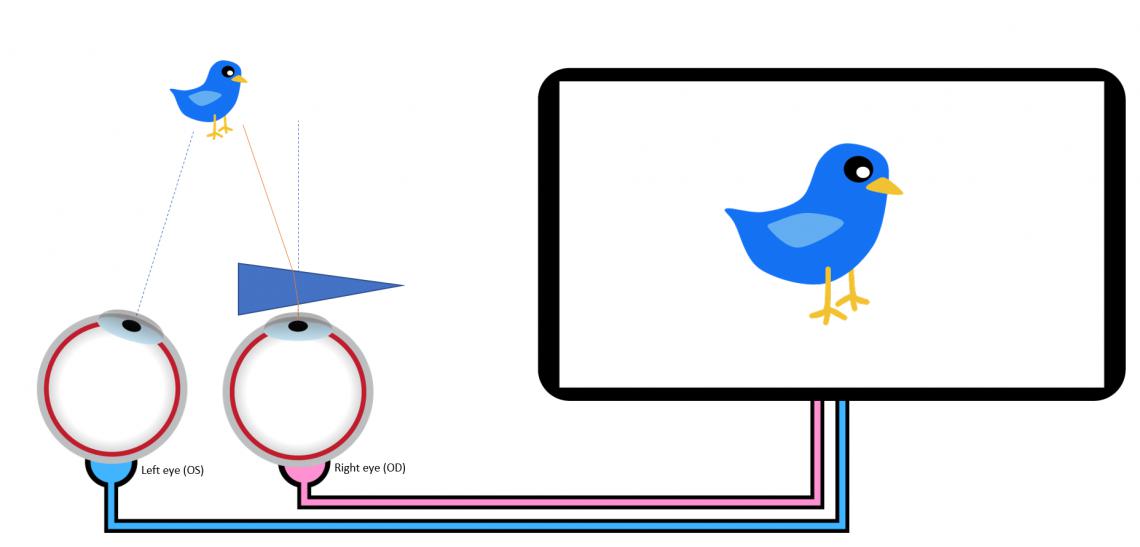Prism Glasses
First, what is a prism? Prisms are unique optical tools that can help patients with double vision, but they are more common than that too. Prisms work by "bending" light (a term called refraction). Prisms can also disperse light - you may have experienced this science class with an experiment where a prism dispersed a beam of white light into the colors of a rainbow. Fun fact! Rainbows form because water droplets disperse sunlight into the seven colors of the visible spectrum. So in that case, the water droplets are prisms! But let's stick to optometric uses of prism...
How do Prism Glasses Work?
Prisms are commonly used in eye care to help patients with double vision. Prism glasses may be either a single lens used over one eye that looks like a normal glasses lens or as a stick-on, or may be used over both eyes.
Let's Use a Simple Example:
In fancy optics terms, prism is a refractive element that rotates (moves) the image of an object. The cross-section of a prism is triangular and the rotation of the image is away from the base (or toward the apex).

Any lens with a prescription power has some degree of prism built into it, so we could say that, technically, any pair of prescription glasses are "prism glasses" (more on this below).
If someone is normally viewing an image, both eyes point to the image and the brain interprets this image as single. For our image below, the screen is our "window to the brain" and shows what the brain sees.

Both eyes are directed towards the blue bird, and the brain interprets this as a single image of a blue bird.
But what happens if an eye is deviated or can't move towards the bird? This is an example of strabismus or an eye turn below.

See the problem? The right eye is pointed away from the bird. The result is double vision (diplopia).
So how does prism help? Well, simply put, prism moves where the image of the bird is to the patient, making the bird appear to align with the deviated eye as shown below. The brain then can put the images together to help the patient see single.

It's important to realize that the bird itself didn't move. The prism lens refracted (bent) the light which matched the displacement of the right eye. If you look closely and follow the orange line, you'll see the light is actually bent twice - once entering the prism, and again (slightly) after leaving the prism. This is due to an optics principle called the index of refraction.
Are Prism Glasses Special?
As stated above, any lens with a prescription power has some degree of prism built into it, so we could say that, technically, any pair of prescription glasses are "prism glasses" - but this is a bit misleading.
Remember that the prism rotates the image away from the base of the prism and towards the apex - so the doctor must specify the direction of the base as well as the amount of prism, and prism may be specified for one eye or for both eyes. The Greek capital letter delta symbol (Δ) is often used to denote prism in a prescription. You may see something like 10Δ BU OD on a prescription, which means "ten prism diopters base-up in the right eye" (OD = oculus dexter = right eye and OS = oculus sinister = left eye) to specify the amount of prism and the direction of the base. Base directions are often BD (base-down), BU (base-up), BI (base-in - in being towards the nose), and BO (base-out - out being towards the ear).
So the prism amount and direction are specific to the patient.
But We Said TECHNICALLY Any Prescription Glasses Are Prism Glasses, Right?
Yes, and here's why. The above example is actually a bit too simple - no patient would be given a triangular lens that looks like that.
Instead, the prism is induced by either grinding the specified amount of prism into the lens or by decentering a prescription lens. You can see how a concave (divergent or minus lens) and a convex (convergent or plus lens) are actually like a combination of prisms!

At the very center of the lens (termed the optical center) no prismatic correction is induced. But, when the eyes look off the optical center, at least a small amount of prism is induced naturally. This can be used to the patient's advantage when creating a lens, but can also cause a problem if the glasses prescription between the right and left eye is drastically different. This is why it's so important for a pair of glasses to have the correct optical center for a patient!
Prism Glasses in Vision Therapy
There are various reasons that a doctor may choose to prescribe prism. Prism lenses can be prescribed to eliminate eye strain and double vision (diplopia). Some situations when an optometrist or ophthalmologist may prescribe them are:
- Strabismus
- Eye strain
- Headaches
- Suppression
- Tiredness with near work
- Traumatic Brain Injury or stroke
Sometimes doctors may label prism as "compensatory prism" or "therapeutic prism," but there are no generally accepted criteria to distinguish these terms and the prism is the exact same from an optical sense regardless of how it's used.
Although prescribing prism can be very helpful, prisms are not without their difficulties. The basic description of what a prism is may seem very straightforward, but there are a number of "side effects" which may diminish the benefits especially for larger amounts of prism. For one thing, the effect of the prism is not uniform across the field of vision and this can create various distortions if the amount of prism is high.
Prisms can also cause a shift in visual space by changing where an image is located. In therapy, this is sometimes intentionally used with what is called yoked prism. Here the base direction is the same for each eye (example: 5Δ BU OD / 5Δ BU OS = five prism diopters base up in the right eye and five prism diopters base up in the left eye).
This concept can be a bit difficult to understand, even for some eye doctors! Yoked prisms create no overall glasses prescription power difference right vs. left eye, BUT yoked prism does change the perception of space by shifting the image location for the visual system. In our 5Δ BU OD / 5Δ BU OS example, the image is shifted DOWN (remember, the image shifts away from the base of the prism = towards the apex, if the base is UP the image moves DOWN), which requires the patient's visual system to make an adjustment to move the eyes down also. To FURTHER complicate matters, a small amount of magnification also occurs, depending on where the image falls along the base-to-apex path.
Confusing, no? What's key to remember as that these optical transformations provided by prism lenses are an important part of vision therapy. There are several procedures that can make use of prisms of various kinds and these are often mounted in glasses frames. These prism glasses may shift the visual environment and require the person to adapt to the visual change through visually directed motor activities. A different pair of prism glasses using a different arrangement of prisms may help a person see single.
Sometimes prisms are only be used in the therapy room to help teach a patient how to consistently use the two eyes work together or to make a patient's visual system learn to cope with visual stressors. Prisms used in these ways for visual training/vision therapy are not typically worn as a habitual prescription, they are instead used only during therapy activities under the supervision of their optometrist and/or vision therapist.
Prism Glasses with Visual Field Loss
This is not as common of a use of prism lenses, but it can be a very helpful one. When a person suffers a loss of part of the visual field due to some trauma or disease, prisms are sometimes used to help them be more aware of the missing part of the field. These may be a fairly simple design that moves the whole field slightly to increase awareness, or it may be a very specialized type of "sighting" prism that covers only part of the field. This can allow the person to monitor the blind field for obstructions or oncoming objects quickly without turning the head or eyes and losing track of straight ahead.
The Vision Wiki
- Lazy Eye Treatments
- Optometric Vision Therapy
- Eye Exercises
- Pencil Pushups
- Brock String
- Vision Therapy
- Sports Vision
- Virtual Reality
- Red Green Glasses
- Vision Therapy for Adults
- Vision Therapy Apps
- Vectograms
- Eye Drops for Amblyopia
- Strabismus Surgery
- Eye Patching
- Prism Glasses
- Dichoptic Training
- Binasal Occlusion
- Eye Problems
- Binocular Vision
- Physiology of Vision
- Lazy Eye
- Reading
- Fields of Study
- Research
- Glaucoma
- Virtual Reality
- Organizations
